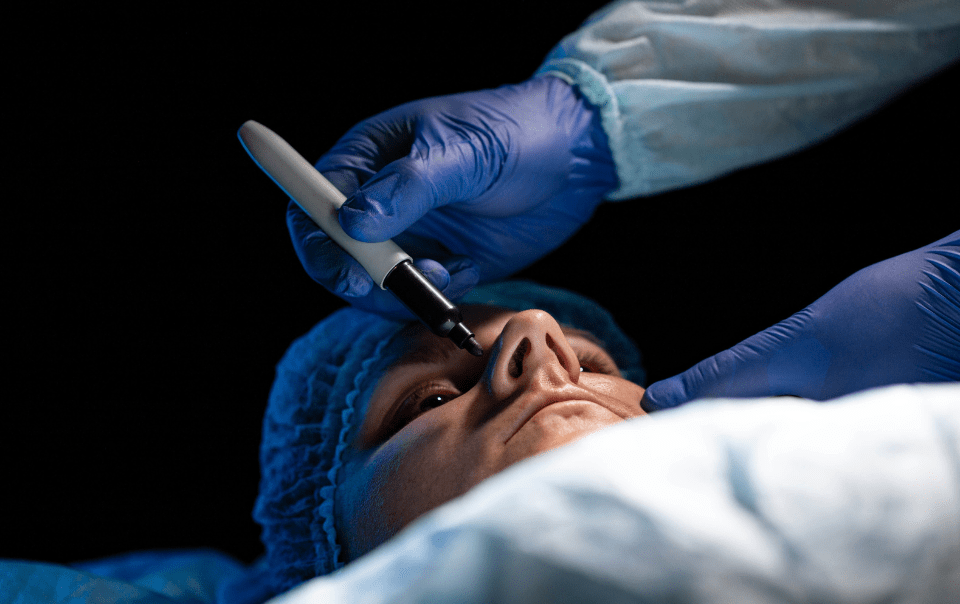Septoplasty is a quick and relatively painless procedure that is recommended for those experiencing breathing difficulties, frequent sinus infections, nasal congestion, and head pain from a crooked or deviated septum. The procedure is extremely safe and straightens the crooked nasal wall to restore breathing function and put an end to the debilitating symptoms.
Septoplasty is one of the many types of nasal procedures offered at the Southern California Sinus Institute. Our patients receive customized post-operative care instructions to follow to ensure their nose heals and normal breathing function returns. Still, many of them have questions about the recovery process. Take a look at some of the most common questions we receive about septoplasty recovery.
- How long does it take to fully heal?
- How hard is recovery?
- How long do you have to sleep upright after septoplasty?
- How should you sleep after septoplasty?
- How long after septoplasty Can I sneeze?
- Can I pick dried blood out of my nose after the procedure?
- How do I unclog my nose after septoplasty?
- Why am I sneezing so much?
- What is the fastest way to recover?
How long does a septoplasty take to heal fully?
This is a surgical procedure that takes a few months for patients to heal completely. Although patients are discharged home shortly after their procedure to start their recovery, initial swelling often lasts two to three days.
The surgery is less complicated than other nose surgeries and many patients feel recovered enough to resume their regular activities sooner, usually within 3-4 weeks. But it takes up to three months for the nose to completely settle and heal from the procedure. If additional nose surgeries or procedures are performed with the procedure, healing and recovery takes longer.
How hard is recovery?
Septoplasty is a minimally invasive surgery performed on the nose. Because the procedure doesn’t require incisions on the external surface of the nose and face, and dissolvable sutures are used close to the surgical site, there is less trauma to the nose and face. The postoperative effects of the procedure are well-tolerated by patients, making recovery easier to get through.
How should you sleep after septoplasty?
The first week after septoplasty is when postoperative pain and discomfort are highest. Many patients find it challenging to sleep during the first few days after their procedure. It’s critical for patients to sleep at a 30-degree to 45-degree incline to keep their head elevated above heart level.
Use pillows or sleep in a recliner to minimize discomfort and the likelihood of accidental trauma to the nose. Sleeping at an incline helps optimize blood flow to the nose which is necessary to alleviate swelling, nasal congestion, bleeding, and pain during recovery.
How long do you have to sleep upright after septoplasty?
In most cases, Dr. Cohen clears patients to resume sleeping on their sides and backs after the first week of their septoplasty recovery. However, extra precautions are necessary to avoid accidental injury or pressure to the nose. If you plan to sleep on your back or side, keep in mind there is the risk of accidental disturbance to the nasal area that can increase or prolong pain and swelling and disturb the treatment area enough to cause the nose to appear uneven and crooked.
In most cases, this clears up by the time septoplasty recovery is complete.
How long after septoplasty can I sneeze?
Sneezing can cause further trauma to the fragile, yet sensitive nose and compromise the procedure’s results. If possible, avoid sneezing through your nose for the first week or two during recovery to reduce pressure in your nose and airways to keep the sutures intact and minimize bleeding, swelling, and pain. Avoid dusty environments and allergy triggers. If you need to sneeze, use surgeon-approved nasal sprays to protect the delicate tissues in your nose.
Can I pick dried blood out of my nose after septoplasty?
Do not pick your nose after septoplasty. It’s important to avoid introducing foreign objects and pathogens into the nose, especially while the wound remains unhealed. The nose is extremely vulnerable to germs and infection during recovery.
To prevent old, dried blood from crusting and obstructing their nasal passages, patients should flush their noses with saline nasal sprays or rinses and drink more fluids for optimal hydration. Some patients find it beneficial to use a swab dipped in hydrogen peroxide to gently remove dried or crusted blood from inside the nose. Doing so helps prevent infection and other healing impairments.
How do I unclog my nose after septoplasty?
Nasal congestion and clogged nostrils are common after septoplasty due to swelling and inflammation. To alleviate the congestion and help unclog your nose, use humidifiers and saline nasal sprays and rinses to reintegrate moisture into the air and your dry nasal tissues. Nasal steroids may be provided to help calm any inflammation and swelling. It’s best to avoid smoke and places with poor air quality as well.
Why am I sneezing so much after septoplasty?

What is the fastest way to recover from septoplasty?
The fastest way to recover from the procedure is to follow your surgeon’s orders and recovery care guidelines to minimize issues that can prolong your discomfort and healing. Failure to do so can mean the difference between a quick and uneventful recovery or one that’s plagued with healing impairments, poor results, and additional follow-up septoplasty recovery appointments with your surgeon.
Key Takeaways
- Septoplasty is a minor surgical procedure in which most patients are healed enough to resume their activities one week after surgery. However, complete recovery can take up to six weeks or three months. Healing and recovery times vary, some patients recover in more or less time.
- Treat the nose with care and follow all recovery instructions, i.e., refrain from sneezing when possible, keep the nostrils moisturized, increase hydration, and attend all follow visits at the Southern California Sinus Institute.
To learn more about septoplasty recovery, contact Dr. Cohen at the Southern California Sinus Institute.

